
Exploring the Philippines at your own pace is an incredible experience, and renting a car is one of the best ways to do it. With thousands of islands, diverse landscapes, and hidden gems waiting to be explored, having your own vehicle lets you reach destinations beyond the usual tourist routes. Car rentals in the Philippines offer convenience, flexibility, and comfort.
This guide will walk you through everything you need to know about renting a car in the Philippines, from requirements for foreign travelers to driving tips and must-know regulations.
Whether you're planning a road trip to stunning beaches, historic sites, or scenic mountain provinces, having your own vehicle allows you to explore top places to visit in the Philippines with more freedom and flexibility, ensuring a hassle-free and unforgettable adventure.
The Philippines has a variety of public transportation options, including jeepneys, buses, tricycles, and taxis. While these modes of transportation in the Philippines are relatively affordable, they can be confusing and overwhelming for travelers unfamiliar with local routes and schedules. Traffic congestion and limited availability in certain areas can also make getting around more challenging.
This is why renting a car in the Philippines is a smart and convenient choice. With your own vehicle, you can travel comfortably, avoid the hassle of waiting for public transport, and reach destinations that are not easily accessible.
Fortunately, several reliable companies offer well-maintained vehicles and seamless booking services, making the car rental process easy and stress-free for travelers.
Key Takeaways
-
Renting a car in the Philippines offers flexibility and convenience, especially for exploring destinations not easily accessible by public transport such as remote beaches, mountain areas, and provincial towns.
-
You can rent cars in major cities like Manila, Cebu, Davao, Clark, and Iloilo, as well as in popular tourist destinations including the islands of Palawan, Bohol, and Baguio.
-
Travelers can choose from various types of vehicles, such as compact sedans for city driving, SUVs for families and road trips, and vans for group travel. Some rental companies also offer self-drive or chauffeur-driven options.
-
To rent a car in the Philippines, you must present a valid driver’s license (foreign licenses are accepted for up to 90 days), a passport or valid ID, and a credit card for the security deposit.
-
Minimum age to rent is usually 21, and some companies may charge a young driver surcharge for renters under 25 years old.
-
Renting a car is ideal for day trips, especially for weekend getaways, road trips, and family vacations.
-
Drivers must observe right-hand driving, seatbelt laws, and traffic rules, and be prepared for varying road conditions, especially in rural areas.
-
You can book car rentals, airport transfers, and vacation packages with transportation through Guide to the Philippines for a smooth and reliable travel experience.
Why should you rent a car in the Philippines?

Public transportation in the Philippines is widely used by locals, but for travelers, it can be complex and time-consuming—especially if you’re planning to visit different provinces or explore beyond major cities. Depending on your itinerary and travel goals, public transport may not always be the most convenient option.
Here are some compelling reasons why renting a car in the Philippines is a better alternative to commuting:
Hassle-free transportation
The country does not have an extensive train network outside Metro Manila, so getting around requires careful planning. While domestic flights in the Philippines are widely available and connect major destinations like Cebu Island, Davao City, and Palawan Island in just a few hours, not all locations have airports or flight routes.
Some destinations require land or sea travel, while others are too close for flights, making buses or rental cars more practical options. The Philippines has several bus companies, each with its own schedules, routes, and terminals. Navigating this system can be challenging, especially if you're unfamiliar with bus station locations or need to make multiple transfers.
- Discover the largest selection of vacation packages in the Philippines, with all travel arrangements, including transporation, expertly arranged for you
For travelers who want to maximize their time and visit multiple destinations, renting a car is a much more convenient option. Instead of researching bus schedules and transferring from one station to another with luggage in tow, you can drive directly to your chosen attractions without the hassle of public transport.
Full-control of your travel time
Renting a car gives you the freedom to explore the places you truly want to see without being restricted by bus departure times or public transportation schedules. Whether you're driving through the lively streets of Manila City, the scenic routes of Cebu Island, or the bustling districts of Davao City, having your own car means you can travel at your own pace and make spontaneous stops along the way.
Unlike buses and public transport, which follow fixed routes and timetables, a rental car lets you customize your itinerary based on your interests and travel style. With your own vehicle, you have the flexibility to go wherever and whenever you want—without worrying about missing the last bus or waiting for a ride.
Create and follow your own itinerary

Renting a car allows you to create and follow your own itinerary without the constraints of public transportation. You don’t have to worry about waking up early to catch a bus or cutting your visit short to meet a schedule. Stay longer at an attraction, leave when you’re ready, or even enjoy a night drive and relax in the morning.
At any time, you can hop in your car and set off to explore stunning waterfalls, hidden caves, and pristine white-sand beaches in the Philippines.
More destinations to discover
The Philippines is an archipelago of more than 7,000 islands, home to famous attractions that draw countless visitors. While the most popular tourist spots are easy to find, many breathtaking destinations remain untouched and rarely explored due to limited public transportation.
With a rented car, you can go beyond the usual routes and uncover hidden gems that most travelers never get to see. Whether you're seeking off-the-beaten-path beaches, secluded mountain retreats, or lesser-known cultural sites, having your own vehicle gives you the freedom to experience a side of the Philippines that few others do.
- Explore the widest selection of tours across the Philippines for seamless tropical adventures to the country's top destinations
Best jump-off points for car rental in the Philippines
When planning to rent a car in the Philippines, the first step is deciding where you’ll be driving. The rental process varies depending on your destinations, so understanding the country’s geography will help you determine the best place to start.
The Philippines is divided into three main island groups: Luzon, Visayas, and Mindanao, each with key cities and towns that serve as ideal jump-off points for car rentals.
-
Luzon is the northernmost and largest island group, home to the capital, Manila City, where the central government is located. Some of Luzon’s popular destinations include Baguio City, Tagaytay City, Batangas Province, La Union Province, and the Ilocos Region. While Palawan Island is also part of Luzon, you’ll need to take a flight or ferry to get there from the main island.
-
Visayas, located in the central part of the country, consists of multiple smaller islands. Key travel destinations include Cebu Island, Iloilo City, Bohol Island, and Bacolod City.
-
Mindanao, the southernmost island group, is known for its diverse landscapes and remote attractions. Notable locations include Davao City, Siargao Island, Camiguin Island, Cagayan de Oro City, General Santos City, Dipolog City, Bukidnon Province, and Zamboanga City.
To get started, decide which island group you want to explore and choose the best city or town as your rental car pick-up point.
Rent a Car in Manila City

If you’re planning to explore Luzon Island’s top tourist spots, opting for car rentals in Manila City is a convenient and flexible choice. Manila City has plenty of attractions that are easily accessible by car. Whether you’re staying at hotels near Ninoy Aquino International Airport (NAIA) or just in the city for a short layover, you’ll find several nearby destinations in Manila City that are worth visiting.
Manila City has an extensive network of highways and flyovers, but traffic congestion is common, especially during rush hours. To make the most of your trip, start your day early and plan your route to visit nearby attractions efficiently.
- Explore the widest selection of tours in Manila City for a hassle-free adventure in the capital of the Philippines
- Find and book the best rates for hotels in Manila City
Understanding local traffic rules is also essential for a smoother experience. Manila City enforces regulations such as the number coding scheme on weekdays to help manage congestion. Be mindful of one-way streets, designated lanes, and loading/unloading areas to avoid penalties.
Destinations in Luzon Island are connected to Manila City by highways and expressways, making it easy to go on a weekend getaway with a rental car. Some of the best road trip destinations near Manila City include Tagaytay City, Batangas Province, and Baguio City. If you're traveling farther north, renting a car in Clark Freeport in Pampanga Province can provide added convenience.
- Check out the ultimate guide to renting a car in Manila City for the best rental options, requirements, and driving tips
Rent a Car on Cebu Island

Road trips in the Visayas region can be challenging since its cities and provinces are on different islands. However, Cebu Island serves as an ideal jump-off point since it is well-connected, thanks to the airport and ferry ports that link it to other parts of the Philippines.
Opting for car rentals on Cebu Island makes it easier to explore not just the island itself but also nearby destinations. With a rental car, you can conveniently visit many attractions on Cebu Island, including its famous white-sand beaches and scenic coastal roads.
Several beachfront hotels on Cebu Island are also easily accessible by car, offering a relaxing retreat after a day of sightseeing. If you're up for a longer drive, you can visit the southern part of Cebu Island, where you can go on a whale shark-watching tour in Oslob town or witness the sardine run in Moalboal town.
Beyond Cebu Island, the Mactan-Cebu International Airport connects the island to other parts of the Philippines. Additionally, the Philippines' Roll-On Roll-Off (RoRo) ferry system makes it possible to bring your rental car to nearby islands. With a car ferry, you can extend your road trip to destinations like Bohol Island, Dumaguete City, Iloilo City, Boracay Island, and Bacolod City.
- Find and book the best flights to Cebu Island
- Get unbeatable rates when you book from the widest selection of online ferry tickets in the Philippines
- Explore the largest collection of tours on Cebu Island for a more seamless adventure
Rent a Car in Davao City

If you're planning an adventure in Mindanao Island, renting a car in Davao City is a great way to explore its stunning landscapes and vibrant culture at your own pace. Davao City is home to Francisco Bangoy International Airport, commonly known as Davao Airport, the largest airport in Mindanao Island. This makes the city a convenient jump-off point for exploring the island’s diverse attractions.
Davao City itself is a must-visit destination, offering a mix of urban attractions and natural wonders. You can explore must-visit spots in Davao City, such as the scenic Eden Nature Park, the iconic Philippine Eagle Center, and the vibrant Roxas Night Market. There are also plenty of hotels in Davao City that cater to different types of travelers, whether you're looking for a luxurious stay or a budget-friendly option.
- Find and book the best flights to Davao City
- Discover the widest selection of tours in Davao City
Mindanao Island’s key cities and provinces are linked by well-maintained national highways, making it an excellent region for road trips. With car rentals in Davao City, you can easily drive to top destinations like General Santos City, Dipolog City, Surigao City, Cagayan de Oro City, and Zamboanga City.
Whether you're chasing breathtaking waterfalls, relaxing on white-sand beaches, or exploring cultural heritage sites, renting a car gives you the freedom to venture beyond the usual tourist routes.
How much does car rental cost in the Philippines?
Renting a car in the Philippines provides the flexibility and convenience to explore the country’s diverse destinations at your own pace. Car rental rates start as low as $30 per day, but prices can vary depending on several factors:
-
Vehicle Type: Compact cars are typically more affordable, averaging about $47 per day, while larger vehicles like SUVs average around $99 per day.
-
Rental Duration: Longer rental periods often come with discounted daily rates.
-
Location: Rental costs may differ depending on the city or region. For instance, renting in major cities like Manila or Cebu City might have different rates compared to other areas.
-
Season: Demand during peak tourist seasons can influence rental prices.
For the most accurate and up-to-date pricing, it's advisable to compare rates from various rental companies and book in advance. This approach ensures you secure the best deal tailored to your travel needs.
What are the car rental vehicle options in the Philippines?
Car rental companies in the Philippines offer a variety of vehicles to suit different budgets and travel needs. Rental rates depend on the type of vehicle you choose, allowing you to select one that fits your preferences and budget.
Keep in mind that vehicle models may vary between companies, but most Philippine car rental providers offer a decent selection, including models commonly found across Southeast Asia. With a wide range of options, you won’t have trouble finding the best cars to rent for your trip.
Small Budget Car Rental

A small car rental in the Philippines is an excellent choice for solo travelers, couples, or small groups. These vehicles typically have smaller engine sizes and limited luggage space, making them the most affordable rental option.
Popular models for budget car rentals in the Philippines include the Toyota Vios, Mitsubishi Mirage, Toyota Altis, Toyota Wigo, Honda City, and Nissan Sylphy. These are among the best cars to rent for city driving and short trips to nearby provinces. Their compact size makes parking easier, and they have low fuel consumption, making them cost-efficient.
While small cars can reach some highland destinations, a larger vehicle with a more powerful engine—such as an SUV or a 4x4—is a safer and more comfortable choice for rough or steep terrains.
SUV or 4x4 Car Rental

SUVs and 4x4 vehicles are designed for travelers who need a more powerful and spacious ride. With larger engines and roomy interiors, these vehicles can comfortably accommodate bigger groups while providing ample space for multiple pieces of luggage.
Examples of vehicles available under SUV car rentals in the Philippines include the Toyota Fortuner, Honda BR-V, Toyota Innova, Suzuki APV, Mitsubishi Strada, and Chevrolet Trailblazer.
SUV car rentals in the Philippines are built for durability and long-distance travel. They perform well in both the dry and rainy seasons and are ideal for trips to highland destinations with steep inclines and rough terrain. If you're planning an adventure that takes you off the beaten path, an SUV or 4x4 rental is the perfect choice for a safer and more comfortable journey.
Luxury Car Rental

Luxury car rentals in the Philippines offer a premium driving experience with spacious interiors, powerful engines, and high-end comfort. While similar to SUVs and 4x4s in size, luxury vehicles take sophistication to the next level with elegant designs and top-tier features.
Popular models in this category include the Lexus ES350, Toyota Camry, and Mitsubishi Montero Sport GLS. These vehicles are best suited for city driving, but select luxury SUVs and 4x4s offer a combination of comfort, durability, and style, making them versatile for various terrains.
Renting a luxury car in the Philippines is perfect for business meetings, romantic getaways, and special celebrations. Whether you're looking to impress clients, enjoy a stylish vacation, or embark on a long drive in total comfort, luxury car rentals provide a seamless and elegant travel experience.
Van Rental

Van rentals in the Philippines are the perfect choice for travelers who need a spacious and comfortable vehicle. With powerful engines and seating capacities of up to nine passengers, vans are ideal for family vacations, group outings, and business trips. Most models also offer ample luggage space, typically accommodating up to four large bags.
Popular vehicles for van rentals in the Philippines include the Toyota HiAce, Nissan Urvan, Toyota Grandia, Mitsubishi Adventure GX, and Hyundai Starex. These vans are built for long-distance travel and highland driving, making them a reliable option for exploring different terrains. They provide a balance of durability and comfort, ensuring a smooth and enjoyable ride even on rougher roads.
Whether you're heading on a sightseeing tour, a corporate event, or an out-of-town getaway, van rentals in the Philippines offer the space and convenience needed for hassle-free group travel.
What are the requirements for renting a car in the Philippines?
Renting a car in the Philippines is a fantastic way to explore at your own pace, and the process is simple as long as you have the right documents. The car rental requirements in the Philippines include a valid passport, a major credit card (Visa, American Express, or Mastercard), and a driver’s license.
Can foreigners rent a car in the Philippines?
If you're visiting from another country, you can easily rent a car in the Philippines. You can use your driver’s license for up to 90 days, provided it’s in English. If it’s in another language, you’ll need to have it officially translated into English by your local embassy.
For those staying beyond 90 days, a visit to the Land Transportation Office (LTO) is necessary to either convert your foreign license to a local one or apply for a Philippine driver’s license.
To ensure a smooth and stress-free journey, always carry your passport, driver’s license, and rental documents while driving. With everything in order, you can fully enjoy the freedom of exploring the stunning destinations of the Philippines.
Tips for driving a car rental in the Philippines

Renting a car in the Philippines is a convenient way to explore, as long as you have all the necessary requirements. When it comes to driving, the roads can feel a bit chaotic at times, but most travelers quickly adjust.
Driving in the Philippines is generally safe, with well-maintained roads, especially in metropolitan cities and provincial capitals. While traffic congestion can be an issue in busier areas, road accidents are not as common compared to other countries.
To make your driving experience smooth and hassle-free, here are some helpful tips:
-
Know the driving orientation. In the Philippines, vehicles drive on the right side of the road, meaning the driver sits on the left side of the car.
-
Plan your trips to avoid rush hour. Traffic can be heavy, particularly in Metro Manila and other busy cities like Cebu City and Davao City. Try to schedule your drives outside peak hours (7–9 AM and 6–8 PM) for a more relaxed journey.
-
Understand the number coding scheme. Metro Manila enforces a number coding system to manage traffic flow. This system restricts vehicles from being on the road on specific days based on the last digit of their license plate. However, this does not apply to most provinces.
-
Follow traffic rules, even if others don’t. Some local drivers may not strictly follow traffic laws, but it’s important to stick to the rules to avoid violations and fines.
Here are a few key road rules to remember:
-
Always carry your valid driver’s license, certificate of registration, and official receipt.
-
Slow down at yellow/orange lights—don’t try to beat the red light.
-
Never drive under the influence of alcohol.
-
Wear seatbelts at all times.
-
Rent only from reputable car rental companies.
-
Avoid swerving, illegal turns, and illegal parking.
-
-
Be extra cautious during heavy rain. Roads can become slippery, and visibility may be reduced. Drive at a safe speed and stay alert.
-
If pulled over, stay calm and follow instructions. If a traffic enforcer signals you to stop, carefully pull over to the side of the road and remain inside your car.
-
In Metro Manila, traffic is managed by officers from the Metropolitan Manila Development Authority (MMDA). They enforce road rules but are not police officers.
-
If issued a violation, the MMDA officer will ask for your license and vehicle registration. Always remain polite and respectful while following their instructions.
-
-
Avoid bribing traffic enforcers. While you may hear stories of bribery, authorities are cracking down on corruption, and attempting to bribe an officer can lead to serious consequences.
-
Use navigation apps for a hassle-free drive. Apps like Waze and Google Maps work well in the Philippines and help you navigate traffic efficiently. Just set up your route before hitting the road to avoid distractions.
By keeping these tips in mind, you can enjoy a smooth and stress-free driving experience while exploring the beautiful destinations of the Philippines. Safe travels!
Frequently Asked Questions About Car Rental in the Philippines
Can tourists rent a car in the Philippines?
Yes. Foreign travelers can rent a car in the Philippines using their valid driver’s license for up to 90 days from their date of arrival. It’s recommended to carry your passport and entry stamp as proof of arrival.
What documents do I need to rent a car in the Philippines?
You need to present a valid driver’s license, a passport or government-issued ID, and a credit card to secure a deposit. Some companies may also require proof of hotel booking or return flight.
How old do I have to be to rent a car?
The minimum age is typically 21 years old, though some rental providers may require drivers to be at least 25 or charge a young driver fee for those under 25.
Can I use my foreign driver’s license in the Philippines?
Yes, most foreign driver’s licenses are valid for up to 90 days. For longer stays, you’ll need to convert it to a Philippine driver’s license through the Land Transportation Office (LTO).
Is it safe to drive in the Philippines?
Driving in the Philippines is safe but can be challenging due to traffic congestion in cities, narrow provincial roads, and unpredictable weather conditions. Defensive driving is highly recommended.
What are the types of vehicles available for rent?
Available options typically include sedans, hatchbacks, SUVs, vans, pickup trucks, and motorcycles. Rentals may also offer manual or automatic transmission and the option for self-drive or chauffeur-driven services.
Are there toll roads in the Philippines?
Yes. Major highways such as NLEX, SLEX, TPLEX, and CALAX are toll roads. Most rental cars are equipped with an RFID or electronic toll pass, but it’s best to ask your rental provider.
Can I rent a car in one city and drop it off in another?
Some rental companies offer one-way rentals, but drop-off fees may apply. Always confirm with your provider before booking.
Where can I drive with a rental car?
You can drive around Luzon, Visayas, or Mindanao, depending on your rental’s allowed coverage. However, cross-island ferry transfers (e.g., Manila to Cebu) may not be permitted or will require special approval.
Can I book car rentals online?
Yes. You can book self-drive and chauffeur-driven rentals, airport transfers, and packages with transportation through Guide to the Philippines, with flexible pick-up points and trusted local providers.

Renting a car in the Philippines gives you the freedom to explore at your own pace, making every trip more convenient and enjoyable. With a wide selection of reliable car rentals, you can find the perfect ride to match your travel needs.
Whether you're planning a road trip to hidden gems or visiting top attractions, having your own vehicle allows you to make the most of your Philippine itinerary. Just remember to follow local driving rules, plan your routes, and keep all necessary documents with you for a hassle-free experience.
Renting a car is just the beginning of an unforgettable journey in the Philippines. Start planning your adventure by exploring the best time to visit, choosing from the best hotels in the Philippines, and discovering must-try activities, must-visit beaches, and hidden gems.












